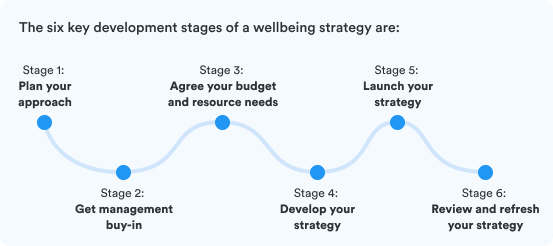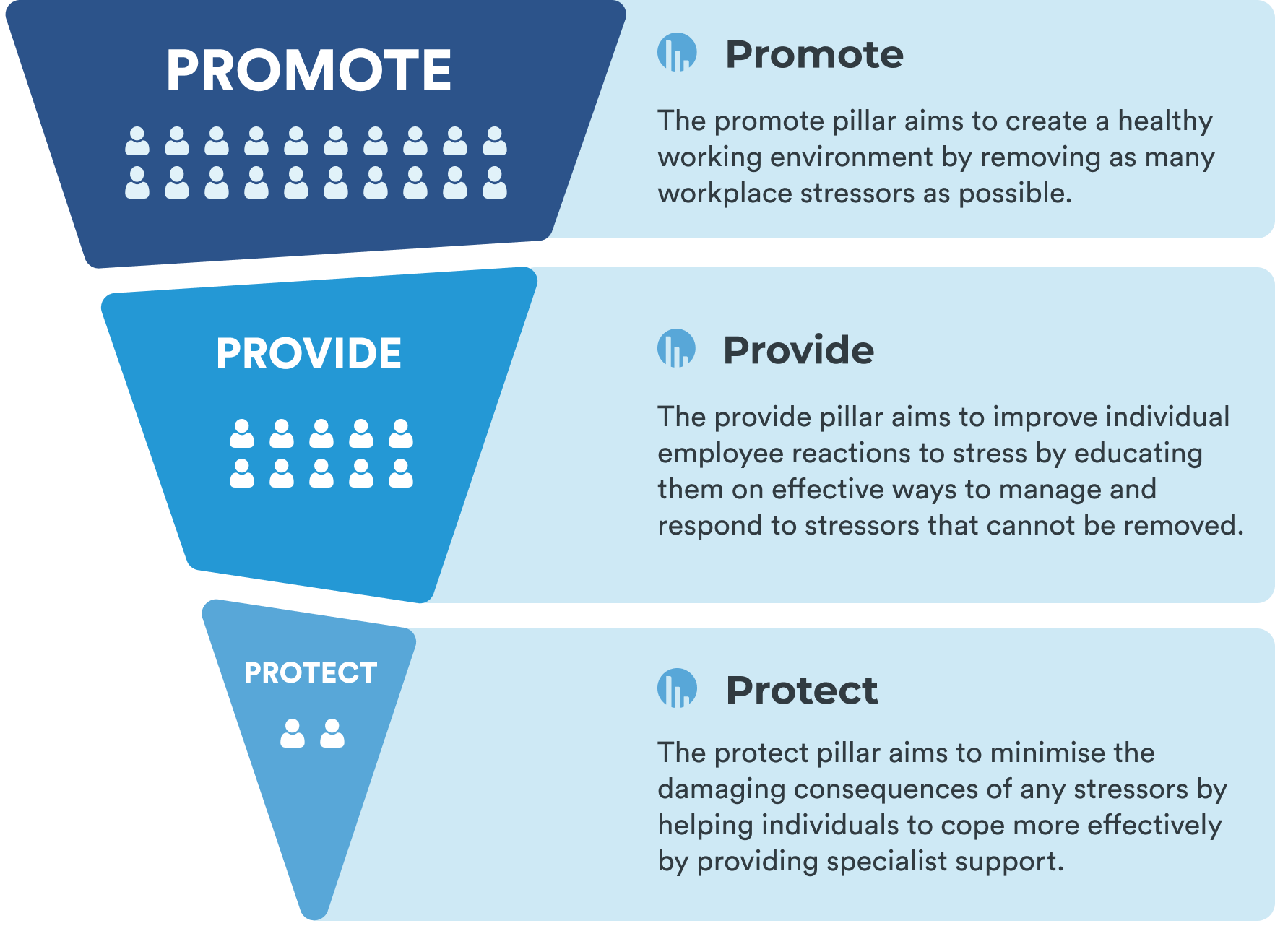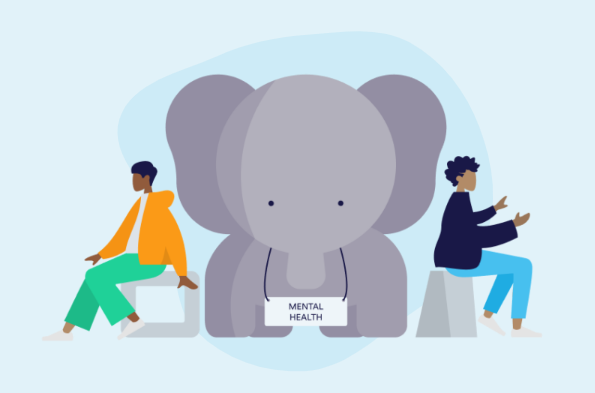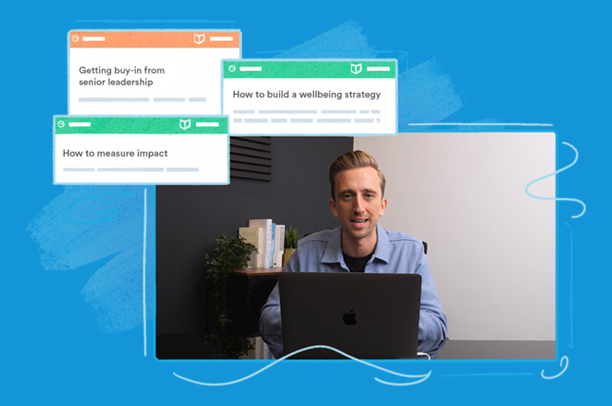2020 and 2021 are two years that reinforced the need for employers to support the mental health and wellbeing of their employees. Through the pandemic, employers realised that employees really do bring their whole selves to work and that the line between work and home life has dissolved. Stress in any area of someone’s life contributes to, or is exacerbated by, stress at work – and employers are now expected to support their workforce every step of the way.
Many organisations already actively support their employees’ wellbeing, but research has found that there is a gap between employee expectations for mental health support and what companies actually offer. Additionally, many employers do not see the results they desire when implementing interventions.
Why? Because for too long, organisations have approached workplace wellbeing by:
~ Running one-off initiatives
~ Relying on Human Resources to solve wellbeing on their own
~ Only providing reactive interventions like an EAP or MHFAs
~ Guessing what employees need
~ Not tackling workplace mental health stigma
This needs to change.
There is a call for a more holistic approach to wellbeing support at work – one that focuses on all aspects of employee wellbeing and that looks at prevention, support and treatment of wellbeing and mental health issues. An approach that is proactive, not reactive; because we need to start approaching mental health in the same way we do physical health, especially in the workplace.
We understand this approach may be new to many employers and it can be hard to know where to start; so we have provided our top three tips to improve employee wellbeing in this article…
- Introduce a proactive employee wellbeing strategy
- Tackle mental health stigma
- Get leadership and people managers on board

Tip 1: Introduce a Proactive Employee Wellbeing Strategy
The first step to improve employee wellbeing and make it an organisation priority is by creating a strategy for the year ahead. Many organisations decide to implement ad-hoc wellbeing initiatives throughout the year; however, the needs of employees and the organisation itself are rarely considered. Developing a cohesive employee wellbeing strategy can help you as a company be clear about your objectives, where you may need to prioritise interventions and activities and help you to think about measuring effectiveness.

Remember: The best employee wellbeing strategies are those that are embedded across all business practices so that employee wellbeing becomes ingrained in the company’s culture. Whilst it might seem a large task, it is clear that developing an effective health and wellbeing strategy is extremely beneficial to all businesses, whether you have 3 or 3,000 employees.
So, what should go into your wellbeing strategy? At Everymind at Work, we have created ‘The 3 Pillars to Improve Workplace Mental Wellbeing’ to make it simple for you…
Our Approach: The 3 Pillars to Improve Workplace Mental Wellbeing
To transform employee wellbeing, we believe that organisations need to implement a wellbeing strategy that is broken down into three key pillars: Promote, Provide and Protect; each informed by the unique needs of the organisation and its employees to have a meaningful and long-lasting impact on employee wellbeing.

For years, businesses have focussed too heavily on the final pillar – Protect. These are reactive solutions (e.g. MHFA’s and Employee Assistance Programmes) that help employees in the midst of a crisis. There is a place for these interventions in the workplace, but they should not be the key focus. Instead, a wellbeing strategy should support a proactive approach to boost employee wellbeing, where the Promote and Provide pillars aim to negate the need for crisis support.
It is important to remember there is no ‘one size fits all’ approach to wellbeing, as every organisation and its employees will have different needs. However, research shows that if an organisation adopts a mixed-intervention approach that Promotes, Provides and Protects employee mental wellbeing, it will be more effective than implementing interventions from just one pillar in isolation.
We like to look at it like this:
100% of employees have mental health – the Promote pillar supports all of them.
80% of employees have struggled with their mental health (as documented in our latest report) – the Provide pillar helps these people.
1 in 6 working-age adults has symptoms associated with mental ill-health [source] – the Protect pillar is there to support these employees.
Pillar 1: Promote
The Promote pillar aims to create a healthy and comfortable working environment by removing as many workplace stressors as possible. A stressor is any factor that causes a state of strain or tension to your employees’ wellbeing. When it comes to the workplace, the risks to employee wellbeing at work, typically fall into one of five categories:
- Job characteristics – job characteristics focus on the factors of one’s job that may make it more stressful, for example, lack of autonomy, decision making, working hours, job tasks, cognitive load, time constraints and resources.
- Role characteristics – role characteristics typically focus on employee purpose, expectations, demands, qualifications and work-life interface.
- The work environment – the work environment includes the physical and psychological environment in which your employees work. Factors to think about include culture, organisational change, communication and physical surroundings such as lighting and room temperature.
- Relationships – relationships at work include the connections between colleagues, managers and leaders, as well as the social support available to employees.
- The individual – the individuality (profile and characteristics) of your employees may make them more susceptible to mental ill-health or require more specific support. Whilst you cannot change this, you can be aware of potential risk factors and mitigate the effects where possible.
The Promote pillar is preventative and targets the work environment, technologies and structures used by your organisation. It focuses on the causes of stress and involves reducing the stigma around mental health, increasing awareness and creating a supportive environment for all employees to thrive.
Everyone has mental health, so the Promote pillar is designed to help every employee feel empowered and safe to have conversations surrounding psychological health without judgement. This has to be the first step. If you do not provide employees with a mental health safe space to work in or a culture where they feel comfortable talking about mental health, the wellness initiatives implemented in later pillars will not be utilised effectively.

Important note:
This pillar is also key to meeting the employer’s legal responsibilities and duty of care to employees; whereby the employer must do all they reasonably can to minimise the risk of work-related mental ill-health as well as physical injury. We understand that many organisations do not know what to look for when it comes to wellbeing risks in the workplace, so we have created the ‘Workplace Mental Wellbeing Risk Assessment’ to support you. We also have a poster that provides a summary of the sources of workplace stress that is useful for employers.
Pillar 2: Provide
We recognise that not all stressors experienced by employees are in the employers’ control and some individuals may be at higher risk of stress or mental ill-health than others. Therefore, the Provide pillar aims to improve individual employee reactions to stress by educating them on effective ways to manage and respond to stressors themselves. This stage is both preventative and reactive to your employees’ needs.
Pressure in life is hard to eradicate, from challenges employees might experience at home to the day to day pressures of work. The Provide pillar is all about equipping employees with the tools and knowledge to be able to deal with that pressure more proactively so that they can effectively manage their own wellbeing.
A key advantage of Provide pillar interventions is that they can be implemented relatively quickly, with little disruption. However, the effectiveness of these interventions does depend on the strength and persistence of the environmental stressors, as well as individual factors. It is therefore important that sufficient consideration has been taken in the Promote pillar for these interventions to be successful.

Pillar 3: Protect
The final pillar, Protect, is reactive and understands that some individuals may need specialist assistance with their mental wellbeing needs; this, therefore, focuses on problems once they have occurred. The aim of this pillar is to minimise the damaging consequences of any stressors by helping individuals to cope more effectively by providing professional support.
Hopefully, by implementing interventions in the Promote and Provide pillars, employees are less likely to call on the interventions or resources available in the Protect pillar. However, the best wellbeing strategies are those that cover all three pillars, supporting employees at every stage.
Think: What pillars do your current interventions cover? Where do you need additional focus?
Don’t forget to use data!
Are you able to measure the impact of your current initiatives? Are you able to justify the requested budget? Do you know what help your employees need?
Lack of data is one of the main reasons employee wellbeing programmes and strategies fail. At a minimum, you should be using the data you have available to:
~ Establish baseline measurements
~ Pitch for budget/gain stakeholder buy-in
~ Understand employee needs
~ Set targets/goals/objectives
~ Track progress
~ Evaluate effectiveness
Tip 2: Tackle Mental Health Stigma
Mental health stigma is the elephant in the room that many organisations fail to address, yet wonder why their mental health and wellbeing initiatives are not working. This is a key element of the Promote pillar discussed above and must be included for a wellbeing strategy to be successful.

Recent research by McKinsey & Company found that 65% of people with a mental illness perceive stigma in the workplace and less than 1 in 10 employees describe their workplace as free of stigma on mental illness. However, ‘reducing stigma’ ranks last when employers list their top mental health priorities, despite 75% of the same employers acknowledging the presence of stigma in their workplaces. Moreover, they found that 80% of employees believe an anti-stigma or awareness campaign would be useful, however, only 23% of employers reported having implemented such a programme.
Unfortunately, this is not surprising as the abstract nature of stigma often deters employers from tackling it; yet the cost of ignoring workplace mental health stigma can be detrimental to both the organisation and its employees.
The cost of mental health stigma in the workplace
For employees with mental health conditions, the stigma they experience from the public, themselves or institutions can exacerbate the struggles they are facing. In fact, nearly 9 out of 10 people with a mental illness feel that stigma and discrimination negatively impact their lives [source]. Below are some of the harmful effects that mental health stigma can have on an individual:
~ Reluctance to seek help and/or treatment, causing delayed or prolonged recovery
~ Increased psychological symptoms
~ Lack of support from friends, family and colleagues
~ Low self-esteem and confidence
~ More likely to experience bullying, harassment and discrimination
~ Feeling isolated and excluded, leading to further social withdrawal
~ Fewer opportunities for employment or social interactions
~ Hesitation to pursue opportunities

Stigma can also have significant effects on working relationships as McKinsey & Company found that:
~ 47% of respondents with a mental illness believe that their colleagues would think they are worthless if they knew about their mental illness.
~ 53% of respondents with a mental illness believe that their colleagues would doubt their character if they found out about their history of mental illness.
~ 50% of respondents with a mental illness believe that their colleagues would think they have little talent or skill if they knew about their mental illness.
Would you know if your organisation is struggling with mental health stigma? Read this article to learn more.
10 key ways to reduce stigma in your organisation
Tackling stigma is no easy feat, but it can be done. This is something we are very passionate about at Everymind at Work, so we created the ‘Mental Health Stigma: The Elephant in the Room’ report to help organisations reduce stigma in the workplace. In the report, we go into much more detail on how stigma can be addressed at an organisational, team and individual level, but here is an overview of the 10 key ways you can reduce stigma in your organisation:
- Educate all employees
- Publicly commit to supporting employee wellbeing
- Promote a healthy working environment by minimising risks to mental wellbeing
- Foster psychological safety within teams
- Empower, educate and encourage people leaders
- Ensure the correct language is used in all communications
- Focus on equality, diversity and inclusion (ED&I)
- Offer appropriate workplace adjustments
- Create conversations
- Share stories
Tip 3: Get Leadership and People Managers On Board
The organisation’s leadership team and people managers are key pieces in the workplace wellbeing puzzle. You cannot tackle stigma or implement an effective wellbeing strategy without them on board; they will make a huge difference to the effectiveness of any wellbeing programme you implement.

Why do you need leadership and people managers on board?
Many managers do not realise the key role they play in staff wellbeing. Your organisation could provide healthy snacks, a discounted gym membership, encourage fitness challenges, run team building days, provide stress management training, offer flexible work schedules and/or provide personal development opportunities… but if employees lack a supportive manager and the senior management team does not buy into the importance of employee health and wellbeing, your staff members will feel it in the workplace culture and interventions will not be as effective.
Forbes uses a nice analogy to explain the different types of managers we often see in organisations:
“A gatekeeper communicates a disregard for wellness. This can manifest in a manager taking lunch at their desk, sending late-night emails, rarely checking to see how team members are doing and investing little time into their own self-care. A gatekeeper likely perceives “wellness” as being something outside of their scope, something HR should handle, and sees wellness as a private pursuit, as opposed to a group endeavor led by managers.
A multiplier attempts to engage with their own well-being. This type of manager exhibits compassion toward team members and leads the team in practices that promote wellbeing, such as mindfulness exercises.”
You need your managers to be multipliers, they will improve wellbeing. This is when you will see happier and healthier employees because you will create an environment that supports employee wellbeing and enables employees to thrive.
How do you create ‘multiplier’ managers?
Multipliers reduce stress, foster supportive relationships, encourage staff to have a healthy lifestyle and boost employee wellbeing. The first step to helping managers become multipliers is to consider mental health awareness training.
Mental health training for managers
Mental health training can really help managers to better support themselves and others but unfortunately, only 24% of managers have received such training (source). Here are some questions to help you consider whether your people managers would benefit from additional training:
Do your managers feel as comfortable talking about mental health as they do physical health?
Are they able to create a healthy and positive working environment for their teams on a day to day basis?
Do they know how to support an employee with poor mental health?
Would they be able to spot the signs that they themselves or a member of their team was struggling with mental health and know what to do next?
Do they role-model and encourage employees to have a healthy work-life balance?
Are they aware of the wellbeing benefits and support available internally and externally?
Do they know how to encourage good working relationships or boost team relationships when needed?
Are they aware of the links between mental and physical health, for example the negative effects of mental ill-health and stress on the body (e.g. headaches, chest pain, digestive problems, cardiovascular disease)?
Do they understand the links between wellbeing and employee happiness, job satisfaction, job performance and overall employee experience?
Once they have this knowledge they can develop the skills to support their own health and that of their teams and co-workers.
Present the business case
Some managers may need more persuading to transform from a gatekeeper to a multiplier and that is where presenting the business case for investing and supporting employee wellness may help. For this, you should use data collected both internally and externally, for example, did they know:
- 17.9 million working days are lost per year to work-related stress, depression or anxiety (source).
- Poor mental health among employees costs UK employers £42bn-£45bn each year (source).
- In 2020, nearly one-third of fit notes issued by GPs were for mental ill-health; making psychiatric problems the most common reason for people to take time off work (source).
- For every £1 spent on mental health initiatives, employers will see an ROI of £5 (source). This increases to an ROI of nearly 11:1 when interventions focus on preventative large scale initiatives, and on using technology to increase uptake by reducing stigma (source).
- Employers could save £1,131 per year per employee by investing in early interventions at work (source).
P.s. If you need help presenting the statistics to your senior leaders and managers, our ‘Why Employee Health and Wellbeing Matters in Business‘ guide might help!
You Don’t Have To Do This Alone
Everymind at Work is on a mission to help employees feel safe to talk about mental health in the workplace.
Think of us as a catalyst for change in your business, helping you to break down mental health stigma and providing crucial proactive support to employees across the year. It all starts with taking the right approach to wellbeing in the workplace.
Our 3 Pillar approach allows organisations to switch from reactive to proactive, providing a framework to build the right wellbeing initiatives and increase employee engagement across the business. Best of all, our people and our stories are the foundation for how we keep things human, connecting with your employees to help them stay happy, healthy and productive.
We know that many HR & People Professionals are given the sole responsibility of implementing and executing an effective employee wellbeing strategy but we are here to help, you are not alone.
If you’re a little unsure of where to start with employee wellbeing or you would simply like to learn more about our proactive approach, you can speak with one of our wellbeing advisors just here.
You can also sign up to our monthly wellbeing webinar for HR or subscribe to our monthly resources to enable us to ease some of the weight from your shoulders.
Equally, if you have any workplace wellbeing questions, feel free to reach out to us or join our Monthly Live Q&A sessions where we cover a variety of workplace problems that HR are experiencing and offer advice on how to better support employees.








